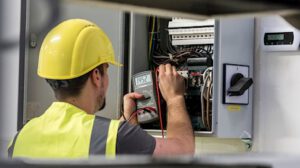There are plenty of things to consider when you’re looking to become an electrician. For example, what are the education requirements for this job? And what can you do to continue to advance your skills in this line of work?

Inside wiremen, Electricians In Scottsdale work on a wide variety of jobs, but they all have one thing in common: they connect the customer’s electrical equipment to the power source. They also install, maintain and repair various types of electrical systems in industrial and commercial buildings. These tasks require a wide range of skills, including the use of power-assisted tools and simple hand tools.
The job of inside wireman electricians is not for the faint of heart. Aside from physical labor, these workers must be knowledgeable about the latest electrical equipment and have the skills to use it.
Inside wiremen, electricians may also install, repair, or maintain electrical equipment and motors. They may work on lighting and fire alarm systems, security camera systems, heating and cooling equipment, and electric door systems.
Although many of the duties listed below are performed by other professions, they are important and are worthy of the name. As a result, inside wiremen electricians are sometimes called “master electricians,” and “master electricians” are able to earn as much as $75,000 a year.
According to the BLS, inside wiremen, electricians are paid a little more than their union counterparts. However, salaries differ by region. For example, a newbie in the field could expect to make an average of $49,367, whereas a union wireman might make as much as $75,000 a year.
Inside wiremen, electricians are skilled craftsmen who can install, repair, and maintain a variety of electrical and mechanical equipment. Many of these professionals have several years of experience working in the residential construction industry, which is the launching pad for their new careers.
It is possible for a skilled worker to learn the inside wireman’s trade through an apprenticeship program. Apprentices must attend a specialized program and take a course in the theory behind the transmission of electrical energy.
Outside electricians, also known as linemen, are responsible for maintaining and installing power distribution systems. These may include transmission and distribution lines, telecommunication cables, and fiber optic cables. Linemen work in a variety of locations, including rural and urban areas. Their work is often physically demanding. They are also required to wear specific professional gear.
The typical day for a lineman involves climbing poles and ladders, installing and repairing power lines, and testing them. They work in virtually all types of weather. Some linemen use a bucket truck to reach high sites.
Some jobs require special certifications. Most linemen require a class-A driver’s license. Licensing requirements vary by state and jurisdiction.
Outside electricians may be hired by a private or public utility company. They can also be employed by a local community college or other professional organization. Many utilities have apprenticeship programs. After completing an electrical program, apprentices can apply for an electrical job.
An entry-level lineman can earn as much as $50,000. However, salaries can vary by region and level of licensing. Typical earnings for an outside electrician were $51,880 in 2015.
Linemen work with a range of tools. They can also work in a variety of settings, including rural and industrial. Some linemen work on bucket trucks, while others climb poles with spikes.
Linemen usually work long hours. They are on call 24/7. They may be called in to replace transformers or to repair damaged or worn-out lines. Often, they are exposed to heavy weather, which can knock out power lines.
Linemen handle high-voltage transmission lines. High-voltage lines are used to transmit electricity from power plants to substations. Licensed high-voltage linemen are required to perform tasks in extremely dangerous conditions. They use extensive personal protective equipment, such as rubber gloves and a Faraday cage suit.
Maintenance electricians work with electrical systems to diagnose and repair malfunctions. They may also perform routine maintenance to keep the equipment running smoothly.